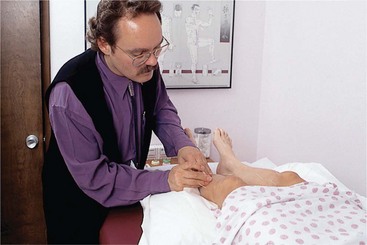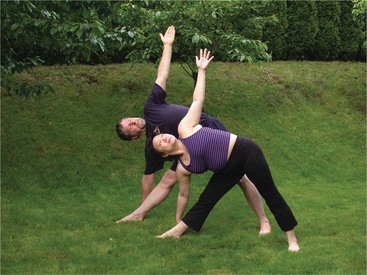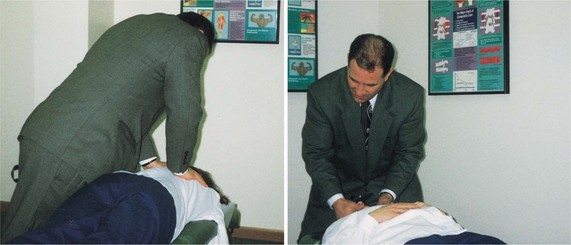Complementary and Alternative Therapies
Upon completing this chapter, you should be able to:
1 Discuss the use of complementary and alternative medicine (CAM) in integrative medicine.
2 Identify therapies that are considered part of CAM.
3 Discuss five commonly used complementary and alternative therapies.
4 Name four mind–body therapies.
5 Direct patients to information needed to make a decision on whether to use an herbal remedy.
6 Describe the desired outcome of spinal manipulation during chiropractic treatment.
1 Assess the use of complementary and alternative therapies by assigned patients.
2 Direct patients to information about complementary and alternative therapies.
This chapter will give you a broad overview of complementary and alternative therapies. Becoming well versed in the therapies discussed here requires many hours of exploration and reading. Learning to provide these services to others involves hundreds of hours of training, and some practitioners, such as chiropractors, must complete a formal training program and pass licensure examinations.
Complementary and alternative medicine (CAM) comprises those therapies that are not presently considered to be part of conventional medical practice. The term complementary therapies is used when these practices are utilized in conjunction with conventional medical treatment. An example would be the use of relaxation therapy along with pain medication to increase a patient’s comfort. They become alternative therapies when they are used in place of mainstream medicine. An example would be eating a special diet to treat cancer rather than undergoing the surgery, radiation, or chemotherapy that has been recommended by one’s physician.
In recent decades, there has been a significant increase in the use of complementary and alternative therapies. There are a variety of reasons for this. For some, it is related to an overall effort to live a healthier lifestyle, which includes alterations in diet and the adoption of specific practices such as yoga (ancient Hindu art for harmonizing the body, mind, and spirit) or daily meditation. Other concerns that lead individuals to investigate or begin alternative practices include a desire to decrease or eliminate the use of standard pharmaceuticals, or the failure of conventional medicine to address their health issues, such as chronic pain. Many people cite the impersonal approach and the focus on cure rather than prevention found in standard Western medicine as the primary reason they sought an alternative or integrative practitioner.
Cost is not a major factor in the decision. Many of the alternatives can be expensive and frequently are not covered by insurance. For a variety of reasons, many people make the decision to invest some or all of the money they have for health maintenance into alternative rather than conventional care.
A growing number of conventional medical providers practice integrative medicine. This means they are providing complementary and alternative care along with conventional medicine and providing a holistic approach with more personalized care and easy access to alternative therapies.
The National Center for Complementary and Alternative Medicine (NCCAM) has been established to provide evidence-based research regarding the efficacy of the various complementary and alternative therapies, and to provide information for the public. The NCCAM website is nccam.nih.gov. NCCAM classifies complementary and alternative therapies into five major categories:
• Alternative medical systems, which are complete systems of theory and practice that often developed apart from and earlier than conventional Western medicine.
• Mind–body interventions, composed of a variety of techniques designed to enhance the mind’s capacity to affect bodily functions and symptoms.
• Biologic-based therapies using substances found in nature, such as herbs, foods, and vitamins.
• Manipulative and body-based methods such as chiropractic, osteopathic manipulation, and massage.
• Energy therapies involving the use of bodily energy fields. These are one of two types:
Examples of these therapies are discussed later in this chapter.
ALTERNATIVE MEDICAL SYSTEMS
Homeopathy, naturopathy, traditional Chinese medicine, and Ayurveda (traditional medicine from India) are examples of alternative medical systems. Each of these is briefly described below.
HOMEOPATHIC MEDICINE
Homeopathy teaches that symptoms are signs of the body’s effort to get rid of disease and that disease can be cured by giving small doses of substances that produce symptoms of the disease or disorder in a healthy person. This process stimulates the person’s natural defenses, alleviating the problem. Homeopathy is based on three principles: (1) like cures like; (2) the greater the dilution of the remedy, the greater its potency; and (3) illness is specific to the individual. Homeopathic remedies are derived from plants, animals, or minerals.
NATUROPATHIC MEDICINE
Naturopathic medicine is a philosophy directed at the prevention of disease. Its basis is the use of natural means to promote health. Lifestyle management, natural foods, massage, and substances such as botanicals, light, and fresh air are used along with regular exercise to maintain the body at a high level of wellness through use of the body’s inherent healing ability.
TRADITIONAL CHINESE MEDICINE
Traditional Chinese medicine is a comprehensive system based on the opposition of polarities (yin and yang); the elements of wood, fire, earth, metal, and water; and the flow of energy or Qi in the body. It focuses on looking for underlying causes of imbalances and patterns of disharmony in the body. Chinese medicine uses over 50,000 medicinal plants, acupuncture, and massage. Tai Chi, a form of stretching exercise that promotes relaxation and increased circulation, and Qi Gong, another type of exercise and stimulation therapy emphasizing breathing, coordination, and relaxation, are also recommended.
Acupuncture
Acupuncture is a branch of traditional Chinese medicine. Very fine needles are used to stimulate certain points on the body along lines called meridians to increase or disperse the flow of energy (Figure 32-1). Studies by the National Institutes of Health have found that acupuncture can be an effective method to treat pain. Acupuncture is also used to increase immunity. It is very important that only sterile needles be used for acupuncture because of the danger of infection and transmission of HIV or hepatitis.
Qi Gong
Qi Gong is a form of Chinese exercise-stimulation therapy that seeks to improve health by redirecting mental focus, controlling breathing, improving coordination, and promoting relaxation. Activation of the natural electric currents that flow along meridians in the body helps to rebalance the body’s own healing capability. Qi Gong has been effective for many people for the management of chronic disease.
AYURVEDA
Ayurveda is the traditional Indian system of medicine dating from before the first century A.D. It uses combinations of herbs, minerals, purgatives, massage, medi tation, and special diets. The focus of Ayurveda is on restoring and strengthening the body, mind, and spirit of the person, and its healing focus is on maintenance of balance and wholeness to prevent illness. Ayurveda is more than medical treatment’it is a way of life, and may incorporate a variety of other practices.
SHAMANISM
Many ancient cultures practice shamanism. A trained practitioner, the shaman, uses techniques to achieve a nonordinary reality, or a “shamanic” state of consciousness. With the patient present, the practitioner journeys to other planes of existence to retrieve information that is necessary for the healing process. The patient and the shamanic practitioner work together to make use of the information obtained. The shaman may perform various ceremonies, including the burning of particular plants and herbs, to bring about the rebalancing of the individual with nature.
FOLK MEDICINE
Folk medicine practices are seen in many cultures. In Mexico, it is called curanderismo. In this practice, illness is seen as an imbalance. This may be between hot and cold in the body, between the patient and the environment, between parts of the body, or between the patient and the spiritual realm. Folk medicine combines many healing practices and is prevalent throughout Latin America. Biologic compounds, foods, and herbs are used to treat the physical components of the illness. The curandero also treats the supernatural components. Susto (fear) is thought to cause the soul to separate from the body, resulting in illness. Mal de ojo (evil eye) generally is thought to affect children and causes fever, irritability, headache, and weeping. Empacho is a gastrointestinal disorder thought to be caused by a blockage in the stomach or intestine. Practitioners are believed to have a don or God-given talent for specific healing and usually specialize in treating those areas of illness related to their don.
AMERICAN INDIAN MEDICINE
In American Indian medicine, healing herbs and ceremonies combined with a spiritual emphasis are used to treat ailing patients. The therapies are based on the belief that spirit, mind, and emotions all interact with the environment. A patient’s disease or disorder is believed to be caused by a disharmony in the patient’s connection to nature, Mother Earth, and the spirit world. The focus of treatment is bringing the patient back into harmony.
There are a variety of forms of therapy that include the sweat lodge ceremony, the sacred pipe, and sacred sage, sweet grass, cedar, and other herbs burned and wafted over the patient with the use of a feather. Herbs may also be used in tea or in a bath, or burned with the smoke inhaled. Shaking of rattles helps break up blocks of dead or jammed energy, and drums align the heartbeat of Mother Earth with the patient’s spirit. All therapies are performed by highly trained medicine people. Specific treatments, ceremonies, and beliefs vary throughout the many tribal cultures that are contained within the designation of Native American. Mainstream medical therapies may be used by the patient as well.
MIND–BODY INTERVENTIONS
Mind–body therapies use a variety of techniques aimed at enhancing the mind’s ability to affect the body. Relaxation therapy and therapies that use creative outlets, such as imagery, music, art, or dance, as well as meditation and prayer, are considered to be mind–body interventions.
RELAXATION THERAPY
Relaxation techniques are used to ease stress and are helpful for a variety of chronic illnesses, including headache, irritable bowel syndrome, hypertension, dysrhythmias, inflammatory bowel disease, and musculoskeletal pain. Relaxation induces a light state of altered consciousness through refocusing, conscious breathing, and body awareness. Chapter 31 describes some specific relaxation techniques.
IMAGERY
Imagery uses a visual stimulus to produce a particular physiologic change that can decrease stress or promote healing. It is useful in decreasing pain, and can be particularly helpful to patients undergoing painful procedures such as bone marrow aspiration. Imagery may produce a physiologic effect on all of the major systems of the body. Chapter 31 contains an imagery scenario.
MEDITATION
Meditation involves focusing attention on a single repetitive stimulus, thereby decreasing all other stimuli. It alters consciousness and can bring a beneficial mind–body response. Meditation induces a restful state and lowers heart and respiratory rates, and may reduce anxiety. It has been helpful for people with asthma, hypertension, diabetes, and other disorders. Meditation can improve productivity and mood and reduce irritability.
BIOFEEDBACK
Biofeedback is a technique that trains the patient to lessen symptoms by learning to control particular internal physiologic processes that normally occur involuntarily, such as heart rate or blood pressure. It has also been successful in managing pain and controlling panic attacks. The internal activity can be measured with electrodes and shown either visually on a screen or as a sound, giving the patient and the practitioner feedback about the internal workings of the body. The person, with practice, can use this information to gain control over the “involuntary” activity. Biofeedback is used effectively for many conditions, but is particularly successful in treating tension or migraine headaches and chronic pain.
HYPNOTHERAPY
Hypnotherapy is used to alter behavior, retrieve memories, and induce anesthesia. A hypnotic state is created in which suggestions are implanted that remain during the posthypnotic period. Many physiologic responses have been observed with patients under hypnosis. Hypnotherapy has had moderate success in helping people to quit smoking and to lose weight. On occasion, people who were not good candidates for general anesthesia have been hypnotized into a deep trance state and were thereby able to undergo a necessary surgical procedure. Not all people are able to be hypnotized.
MUSIC, ART, AND DANCE THERAPY
An artistic medium is used to help the individual neutralize conflict or work through a problem. Art therapy has proven helpful when the person has difficulty expressing feelings verbally. Music therapy is beneficial for the expression of feelings, reduction of stress and anxiety, and enhancement of relaxation, or as a distraction to aid in pain management. Dance therapy promotes recognition of feelings and awareness of the body. Its goal is to integrate body and mind and promote self-esteem.
YOGA
Yoga, a word derived from the Sanskrit meaning “union,” is a spiritual practice that combines exercise, controlled breathing, posture, and mental focus to bring about positive effects on the body and mind (Figure 32-2). It began as part of the ancient medicine system of India, Ayurveda. Yoga has been effective for regulating blood pressure and heart rate, increasing circulation, aiding digestion, healing chronic back pain, and helping with other disorders. Yoga may also be practiced for exercise and stress reduction without a spiritual connotation.
HUMOR
Humor has proven to be very helpful as a complementary treatment. It can speed the course of healing and decrease pain. Watching movies or comedy sketches or reading humorous literatuw seems to have a positive effect on the body (Cultural Cues 32-1). Humor generally will raise spirits and help to bring about a more positive outlook.
PRAYER
The offering of prayers to a higher power helps reduce stress, promotes healing, and may arrest disease. Prayer or spiritual healing may be practiced individually or in groups as intercessory prayer. Prayer chains, in which different people pray for a set time for an individual’s recovery over a period of hours or days, are considered beneficial by many people. Research has shown that prayer can be effective in healing. Chapter 14 presents further information on the spiritual aspects of healing.
BIOLOGIC-BASED THERAPIES
Biologic-based therapies use natural substances, such as foods and herbs. Dietary supplements and vitamins also fall into this category. Many of these therapies are as yet medically unproven. Various clinical trials and research projects are under way at the National Institutes of Health to verify the effectiveness of various herbs and supplements. Vitamins, supplements, and herb therapies are used by many patients.
HERBAL THERAPY
Herbal therapy, or phytotherapy (plant therapy), is used by more than 70% of the world’s population as a major form of treatment for disorders of the mind and body. Herbal medicines contain plant material as their active ingredients and are used to treat a wide variety of health conditions. There are far too many herbs to discuss each one here. There are handbooks and texts about herbs, and much information can be found on the Internet. There are many safe and effective herbs, but others can be dangerous. Herbs may interact with various prescription drugs. Contraindications to taking an herb should be checked before use is started. Table 32-1 lists some herbs determined to be safe, mostly by research through the German E Commission. Table 32-2 lists the herbs known to be unsafe. Herbal preparations are not regulated by the U.S. Food and Drug Administration (FDA), but are regarded as food supplements and subject to those regulations. Only a few have been scientifically researched in the United States as to efficacy and safety.
Table 32-1
Safe or Effective Herbs as Determined by Non–U.S. Regulatory Authorities
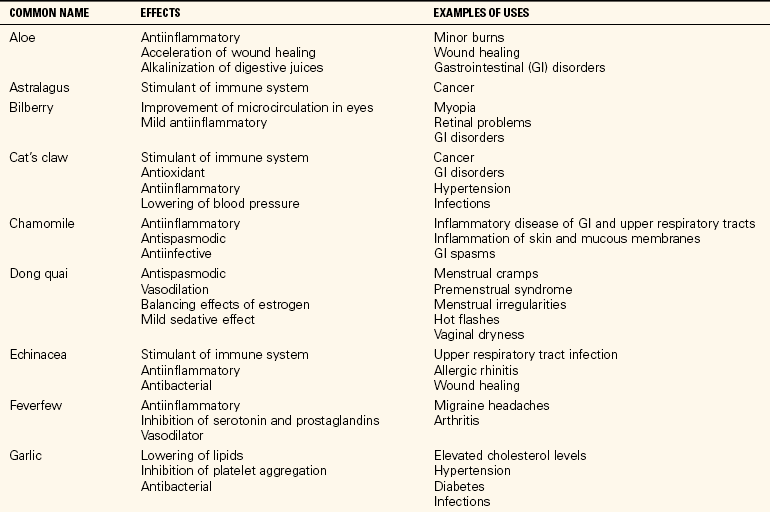
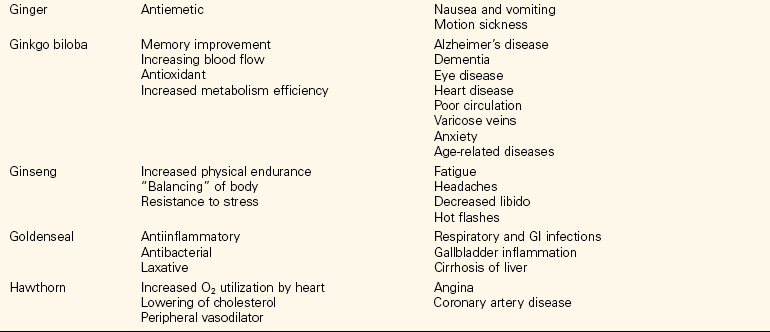

Adapted from Lewis, S.L., Heitkemper, M.M., Dirksen, S.R., et al. (2007). Medical-Surgical Nursing: Assessment and Management of Clinical Problems (7th ed.). St. Louis: Mosby.
Table 32-2
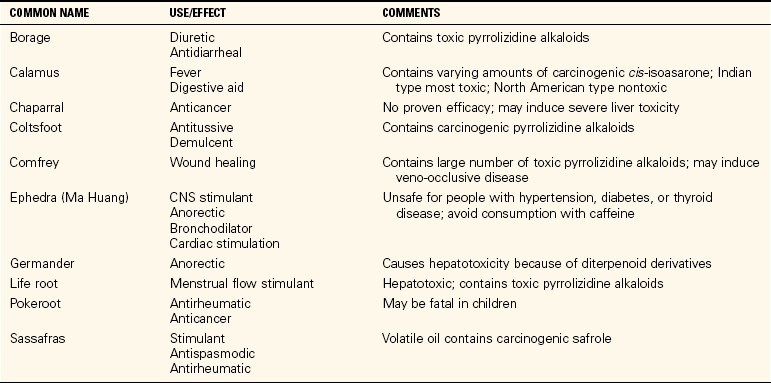
From Lewis, S.L., Heitkemper, M.M., Dirksen, S.R., et al. (2007). Medical-Surgical Nursing: Assessment and Management of Clinical Problems (7th ed.). St. Louis: Mosby.
Increasing concerns about both the cost of prescription drugs and their toxic side effects are causing many patients to turn to herbal remedies to treat their maladies. Echinacea is used to combat cold symptoms, and ginkgo biloba is taken to improve memory. Some older men take saw palmetto to shrink the hypertrophy of the prostate gland that comes with age. St. John’s wort is used to combat mild to moderate depression. Many women rely on black cohosh rather than hormone replacement therapy to treat the hot flashes and mood swings of menopause. Ephedra, or Ma Huang, once a common ingredient in weight-loss preparations, is a cardiac stimulant and can cause a variety of adverse side effects, including death. Sale of weight-loss products that contain ephedra have been banned by the FDA, and patients should be counseled to stay away from this herb. Information on various herbs and supplements can be found on the Internet. One database is at www.herbmed.org. Information on supplements is available from the Food & Nutrition Information Center at www.nal.usda.gov/fnic/resource_lists.shtml.
MANIPULATIVE AND BODY-BASED THERAPIES
These therapies involve some form of manipulation, movement, or touch performed on parts of the body. Chiropractic manipulation, massage, reflexology, and acupressure are body-based therapies. Reflexology uses pressure points on the feet and sometimes the palms and ears to relieve symptoms. Acupressure is similar to acupuncture, except it uses pressure points rather than needles.
CHIROPRACTIC
Chiropractic uses manipulation of the spine for symptomatic relief and improved functioning by bringing the spinal components back into correct alignment, thereby decreasing or eliminating pain (Figure 32-3). Exercise, ice, heat, electrical stimulation, and massage may be used in conjunction with spinal manipulation. The treatment does not usually include the use of drugs. Chiropractic is becoming more mainstream as health care providers refer patients to a doctor of chiropractic medicine. Health insurance will often pay for this therapy.
ENERGY THERAPIES
The use of energy fields is the core of energy therapies. Biofield therapies are supposed to affect energy fields that surround and penetrate the human body. Such energy fields have not yet been scientifically proven to exist. Examples include Qi Gong, Reiki, and therapeutic touch. Bioelectromagnetic-based therapies are based on the use of electromagnetic fields. A therapy may use pulsed fields, magnetic fields, or alternating or direct current. The use of magnets on a body part to relieve pain is an example of a bioelectromagnetic therapy. The research showing the effectiveness of the therapy is largely historical or anecdotal, but there are some studies validating the notion that magnets reduce pain for some people.
REIKI
Reiki stems from the Japanese word meaning “universal life force energy.” A practitioner acts as a conduit for healing energy that is directed into the person’s energy field or body. The practitioner channels energy to the person and the person’s body does the healing. Energy flows through receptors in the crown, forehead, throat, heart, stomach, abdomen, and groin.
THERAPEUTIC TOUCH
Therapeutic touch is a technique used to alter body energy fields to restore natural healing powers. The hands of the practitioner are passed over the client to ascertain where tensions or excessive energies exist. Touch may be used to redirect energies and reestablish energy balance. Although energy therapies seem to help some individuals, there is a lack of controlled scientific studies validating that the techniques work.
THE NURSE’S ROLE IN COMPLEMENTARY AND ALTERNATIVE THERAPIES
The nurse should be knowledgeable about the various types of complementary and alternative therapies so that basic information can be given to patients if they ask. It is vital for health care providers to know if patients are taking over-the-counter herbal or homeopathic substances, because these may interact with prescription medications. For example, ginkgo biloba prolongs bleeding time, and this can cause an interaction for a patient who is receiving warfarin (Coumadin). Mixing fluoxetine (Prozac) with St. John’s wort can cause toxicity.
Patients may request a referral to a CAM practitioner. Referrals to a specific practitioner are not part of the role of the nurse. You can and should explain the necessity for determining the educational background, qualifications, and certification of any practitioner before seeking services. Whenever a patient is using any of these therapies, the health care provider should be informed.
Patients should be questioned about the use of a CAM therapy in a nonjudgmental manner. It is not the nurse’s place to encourage or discourage the patient’s use of alternative or complementary therapy. This is a decision that must be made by the individual patient. The nurse should only guide the patient on where to find information about the therapy and how to choose a practitioner. The patient should find out about how many treatments will be required, the cost of treatment, and the possible benefits.
NCLEX-PN® EXAMINATION–STYLE REVIEW QUESTIONS
Choose the best answer(s) for each question.
1. Your patient asks you what phytotherapy means. You respond that it refers to:
1. plant, animal, or mineral substances given in small amounts used to diminish symptoms.
2. plant-based prescription drugs used to treat allergies.
3. homemade remedies handed down from generation to generation.
2. Biofeedback is considered a type of __________________________ therapy. (Fill in the blank.)
3. It is important to know if a patient is using herbal therapies because:
1. certain herbs can interact adversely with prescription drugs.
2. herbs block the action of most prescription drugs.
3. herbs often cause odd side effects that may mimic disease.
4. Chiropractic therapy: (Select all that apply.)
1. is rarely covered by insurance.
2. is usually used in combination with pain-relieving medications.
3. uses spinal manipulation to relieve pain and restore function.
4. may be combined with exercise, ice, heat, and electrical stimulation massage.
5. The practice of using complementary and alternative therapies along with mainstream medicine is called:
6. A logical choice of a complementary therapy for a person who has difficulty expressing her feelings might be:
7. An herb once commonly used in weight-loss preparations and now banned by the FDA is:
CRITICAL THINKING ACTIVITIES ? Read each clinical scenario and discuss the questions with your classmates.
What would you say to a patient who has been suffering with back pain who wants to try a Reiki practitioner?
 ,
,  ,
,  ,
,  ,
,  ,
,  ,
,  ,
,  ,
, 